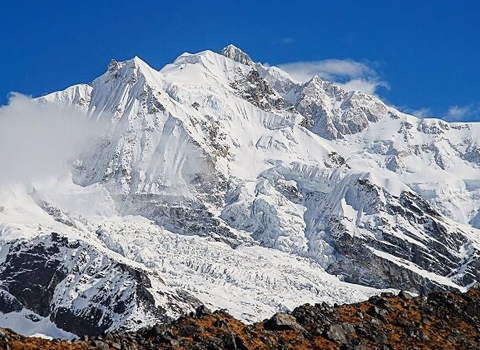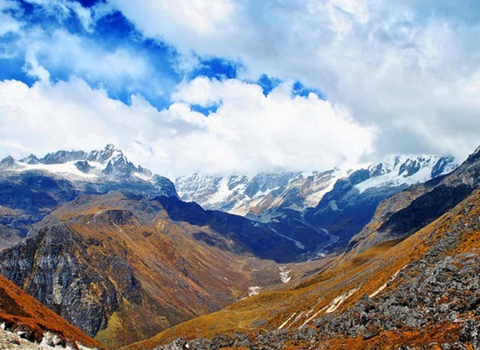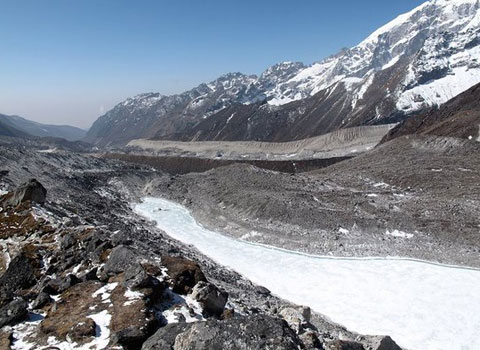Overview
Region: Leh,Ladakh,J&K
Duration: 9 Days/8Nights
Level: Difficult
Distance: 75kms Trekking
Altitude: 11,123ft
Pickup Point: Leh airport
Drop Point: Leh airport
Best Season: Mid January to Mid February
Base Camp: Chilling
Brief ITINERARY
Day-1
New Jalpaiguri to Yukosum . (The pick up is at 10.00 am from NJP.)
Day-2
Yuksom 5643 ft to Bhakim/Sachen ( 8654 ft; 5 hours)
Day-3
Bhakim 8654 ft to Tshoka ( 9701 ft; 4 hours)
Day-4
Tshoka 9701 ft to Dzongri 13024 ft via Phedang (12083 ft; 6 hours)
Day-5
Dzongri 13024 ft to Dzongri top 13566 ft and back to Dzongri ( 3 hours)
Day-6
Dzongri 13024 ft to Thansing 12946 ft via Kockchurang 12152 ft; ( 6 hours)
Day-7
Thansing 12946 ft to Lamuney (13743 ft; 2 hours)
Day-8
Lamuney 13743 ft to Goechala 16272 ft, back to Kockchurang (12152 ft; 12 hours)
Day-9
Kockchurang 12152 ft to Tshoka ( 9701 ft, 6-7 hours)
Day-10
Tshoka 9701 ft to Yuksom (5643 ft; 6 hours)
Day-11
Drive from Yuksom 5643 ft to NJP. (You will reach NJP by 5 pm).
DETAILED ITIERNARY
Day 1 - New Jalpaiguri (NJP) to Yuksom
Altitude - 5700 ft.
Distance1-50 km drive,
Time taken - approx 8 hours
Reach NJP by 9.30 AM. Himveer Tour & Trek personnal will greet you at 10am NJP railway station. Drive towards the base camp in a shared taxi. Enroute have lunch. You will reach the base camp late in the evening.
Pass through Police Check Post at Melli. Foreigners need Inner Line Permit (ILP) – (The driver will help get it. Procedure takes half-an-hour).
From NJP to Melli. @ the border of Sikkim and West Bengal
Lunch break at Jorthang Last ATM at Legship
Base camp at Yuksom.
Overnight in guest house
Day 2 - Yuksom to Siachin
Altitude- 7200 ft.
Distance- 8 kms trek,
Time taken - approx 6 hrs
Abundant water sources.
Have packed lunch en route.
After breakfast at the camp start trekking towards Siachen through dense forests, with frequent ascent and descent. After half-an-hour walk from Yuksom, you can see Tshokha. Trail passes through three iron bridges (Gradual ascent till the first bridge, steep ascent for 20 min then gradual descent till second bridge and gradual ascent till third bridge). Walk for half an hour to the camp site. Siachin campsite is in the forest, so accommodation in tents. Dinner and overnight stay in tents.
Day 3 - Siachin to Tshokha via Bakhim
Altitude - 2524mts
Distance - 7 kms trek
Time taken(approx) - approx 5 hrs
Welcome the refreshing clear morning the next day and get prepared for a journey to Tshokha at 9,700 feet via Bakhim located at an altitude of 8600 feet.The trek to Tshoka is steep. We first cross the wooden bridge over PERK river. The bridge is lined with Buddhist prayer flags and swings as you walk on it .After crossing the bridge we climb into the forest of oak & rhododendron. The local malt Tumba is pretty popular. You will find cafes at Tshoka . From the monastery at Tshoka, get the fantastic views of Mt. Pandim and the entire Kanchenjunga range. Overnight we will be doing camping here.
We trek again on frozen ice towards the designated camping site for the day. Overnight at camp
Day 4 - Tsokha to Dzongri via Phedang
Altitude - Phedang at 10500 ft/ Dzongri at 12980 ft
Distance - 9 kms trek
Time taken - approx 7 hours
He trail is mostly ascent - Tsokha to Phedang - 4.5 kms, 3 hrs and Phedang to Dzongri - 4.5 km, 3 hrs For the first hour, trail is rocky, for two hours it is wooden trail and once again rocky, zig-zag trail till camp site.
Carry packed lunch and enough water as there are no sources of drinking water en rout.
This is the day which all Goechala trekkers look forward to. If you come here in spring the trail passes through the densest forests of blooming colourful Rhododendrons. After a few hours into the trek we reach Phedang, a large clearing with superb mountain views. Continue on the trail & reach Dzongri . It is large meadow surrounded in all direction from Snow clad peaks of Kanchenjunga range. Enjoy the experience of surrounded by Himalayan might from all directions Don’t forget to ask for the names of peaks from your guide.
Camp overnight at Dzongri.
Day 5 - Rest day in Dzongari
Altitude- Trek to Dzongari top at 13,675 ft
Time taken - approx 1 hour
Peaks spotted- Frey Peak, Kumbakarana, Rathong, Kabru South, Kabru North, Kabru Dome, Kangchenddzonga, Jupono, Pandim, Simro
Instruction- Do not sleep, especially inside the tents, during the day. Go for small walks and explore the vicinity
Dzongri top is a two hill climb from the Dzongri trekkers hut. The trek from Dzongri to Dzongri top takes about 45 mins. The sun rises at 5 am and you don’t want to miss seeing the first rays of sun hitting Kangchenjunga. Start your trek at 4.00 a.m with torch lights and you reach the top just as the dawn breaks. Dzongri top i.e at 13681 feet, is the highest point from where you get the 180 degree panaromic view of the mighty peaks of the Singalila and Kanchenjunga ranges.
Day 6 - Dzongari to Thansing via Kokcharang
Altitude - Kokcharang at 12,000ft/ Thansing at 12900
Distance - 10 kms tre,
Time Taken - approx 6 hrs
Dzongari to Kokcharang 8 kms trek, approx 4 hours
Gradual walk through meadows and descend to reach Kokcharang Refill water at Kokcharang
From Kokcharang, walk to the bridge towards Prekchu river. Rest and then ascend for 2 kms to reach Thansing
Enjoy hot lunch at campsite
Wake up early before sunrise & start trek to Dzongri top. From the top you will get a 180 degree view of the peaks of the Singalila and Kanchenjunga ranges. Watch the sunrise from behind the mountains & its first rays falling on the top of peaks. Thansing can be seen from the top. The trail decends upto Kockchurang and then climbs upto Thansing. The Prekchu river flows through the trail. As you cross the river from a bridge experience the cool breeze .From the bridge Thansingh is about 2 kms. Trail goes over rocks & boulders till you reach Thansingh. Thansing is also a meadow . We will pitch our tents here. The night is going to be cold here.
Day 7 - Thansing to Lamuney
Altitude - 13650 ft
Distance- 4 kms trek
Time Taken- approx 2 hours
Morning call 8-9-10 (8am: tea, 9am: breakfast, 10am: Move for Lamuney)
Easiest day of the trek - easy trail
Enjoy hot lunch at camp site
Trek further to Samiti Lake for 2kms
Todays trek is easy with mostly flat trail. Within 2-3 hours of starting the trek we will reach Lamuney . About half an hour from Lamuney over a steep rocky trail lies Samiti Lake. There is a good chance of spotting mountain goats and blue birds on shores of the lake. Camping is not permitted by the lake. After spending some time on the shores of this beautiful lake we head back to our camps at Lamuney.
Day 8 - Lamuney to Goechala via Samiti Lake back to Lamune Trek to Thansing (or Kokcharang, depending on the trekkers’ speed/weather)
Altitude - 16,000 ft
Distance- 18 kms trek
Altitude -Time Taken: 13 hours
Longest and toughest day of the trek
{Pack your backpack at night only, so when we return, we just have food and leave for lower campsite}
Lamuney to Samiti Lake easy walk for one hour
Lamuney to View Point 1 (15100 ft - 5 kms – 3 hrs) Steep ascent for 2 hours
View Point 1 to Goechala lake (15,700 ft – descent – 1.5 hours) /View Point 2 (16,000ft – steep ascent 40 mins)
Move ahead of View Point 2, if weather allows.
Descend to Lamuney for hot lunch
Descent further to Thansing/Kokcharang
Peaks spotted: Kabru South, Kabru North, Kabru Dome, Kangchendzonga, Gocha Jupano, Pandim, Sinvo, Tenzingkhang Today is the most challenging day as we trek upto Goechala & return to our camps on the same day . But we have the advantage of leaving some of heavy stuff from our rucksack at the Thansingh camps & trek with lighter load. The distance is long & steep so we start way before sunrise. Continue on the trail till you reach Goecha La. The view from Goecha La is breathtaking with Mt. Pandim and Kanchenjunga standing right in front of you. Spend some time here and then descent to Thansing .After spending some time at the View point and admiring the beauty at the most, descend to Lamuney at the earliest. On reaching the campsite at Lamuney cherish a hot lunch and pack the belongings for a further descend to the next campsite at Thansing or Kokcharang. It is better to descend as much as possible in the same day before opting for the campsite. However on reaching Thansing, it can be called a day with a good night sleep at the tents.
Day 9 - Thansing/Kokcharang to Tsokha via Phedang
Altitude - Thansing 12,900 ft/ Kokcharang 12,000 ft to Tsokha 9700 ft
Distance- 16 kms trek
Time Taken- approx 7 hours
Start around 7am to reach by 3 pm Tsokha
Carry packed lunch
Kokcharang to Phedang (12 kms, approx 4 hrs) - gradual ascent and descent in the Rhododendron forest
Phedang to Tsokha - descent for 5 kms
The trail is through forest and the gradient is mostly flat, with small ascends and descends. Be careful while on descending trails & trek slow. Rhododendron trees line your way all along and the Prekchu river flows below. Camp overnight at Tshoka..
Day 10 - Tsokha to Yuksom via Bakhim and Siachin
Altitude - 5670 ft
Distance- 15 km trek
Time Taken- approx 6
The trail is a complete descent on the same route as day 2 and 3 Carry packed lunch
Retrace the same path from Tshoka to Yuksom. Its an easy trek. Take a quick halt at Sachen. From Sachen the trail goes up and down with mosty downhill. The last section has a few ascents before you reach Yuksom. This is the last day of trek.Stay overnight at Yuksom.The trip ends here.
Day 11 - Yuksom to New Jalpaiguri
Altitude - 5670 ft
Distance- 150 km drive
Time Taken- approx 8 hours
The trail is a complete descent on the same route as day 2 and 3 Carry packed lunch
Leave Yuksom early morning to reach NJP by 5.00 pm Pack your backpack at night only, so you don’t have to be in rush before leaving for NJP
POLICIES AND PAYMENTS
POLICIES AND PAYMENTS
a) 46 Days or more before date of departure: 25% of total cost.
b) 31- 45 Days before date of departure: 50% of total cost.
c) 30 days before date of departure: 100% of total cost.
IMPORTANT: The booking stands liable to be cancelled if 100% payment is not received less than 30 days before date of departure.
CANCELLATION POLICY
*CANCELLATION CHARGES PER PERSON
a) 30 DAYS OR MORE BEFORE DEPARTURE: 25% OF TOTAL COST
b) 29 - 20 DAYS BEFORE DEPARTURE: 50% OF TOTAL COST
c) LESS THAN 20 DAYS BEFORE DEPARTURE: 100% OF TOTAL COST
*IF WE CHANGE OR CANCEL YOUR HOLIDAY
We do plan the arrangements in advance. It is unlikely that we will have to make any changes to your travel arrangements.
Occasionally, we may have to make changes and we reserve the right to do so at any time. If there are any changes, we will advise you of them at the earliest possible date. We also reserve the right under any circumstances to cancel you travel arrangements by assigning reasons to you.
If we are unable to provide the booked travel arrangements due to reasons beyond control ( e.g. bad weather, insufficient bookings) we shall first try to offer alternative dates for the tour if the tour has'nt already commenced. If the alternate arrangement does not suit you, we will refund the amount in full.
*IF YOU WANT TO CHANGE YOUR HOLIDAY PLAN.
After confirmation of services, if you wish to change your travel arrangements in any way (e.g. your chosen departure date or accommodation), we will do our utmost to make these changes but it may not always be possible. Any request for changes must be in writing from the person who made the booking. All cost incurred due to amendment will be borne by you. All booking vouchers and tickets will be provided 3 days before departure
Cost Terms
COSTS INCLUDES
All transfers in shared taxi ,right from PICKUP POINTS to DROP POINTS
Permits and Entrance fees.
Accommodation in tents on share basis during trekking.
All meals, { from BASE CAMP to BASE CAMP} Breakfast, Packed Lunch, Tea, Coffee, Sneaks, Soup, Dinner, after dinner hot Chocolate, lemon tea. etc!
All camping gear including tents and sleeping mattress. Liner,Kitchen tent, Dining tent and toilet tent.
Good Experience Hindi/ English guide, cooks and porters, mules.
Insurance of Himveer Tour & Trek staff.
COSTS EXCLUDES
Personal Insurance.
Personal toiletry Items
Personal expenses and tips
Personal Medicine kit
CMeals during transit.
Charges of mules/poerters carrying extra luggage. (Rs 300/per bag payable to Himveer Tour & Trek Personnel at the base camp )
How to Reach
By Air :-
Flying to Bagdogra is another option that you can choose though flights to Bagdogra tend to be pricier than those to Kolkata. Most of the flight foremost metros in the country come here
By Train:-
New Jalpaiguri or NJP is a major railway station located in south west of sikkim. There are many long distance trains arrives or pass through the NJP station. You can choose to come to Kolkata and take one of the many trains to NJP. If you are coming from Delhi or north part of India, try to take any north east train which directly goes to NJP by passing Kolkata.
Himveer Tour & Trek GUIDELINES
DO’S AND DON’TS ON A TREK
1.Alcohols or any other intoxicating products "STRICTLY PROHIBHITED" during the trek.
2.Always pay heed to the trek guides or instructors.
3.Try not to leave the group under any circumstances.
4.Avoid trekking during the nights as it is extremely dangerous.
5.Avoid using earphones as that might hinder your hearing.
6.Do not participate or encourage littering of the places in any form.
7.While visiting the local villages and tourist sites, obey the local guidelines and instructions.
8.Do not harm or interrupt the local sentiments of the places.
IMPORTANT:
Your safety is of paramount concern while travelling with Himveer Tour & Trek.
Please note that your leader has the authority to amend or cancel any part of
the itinerary if it is deemed necessary due to safety concerns.
Since adventure entails travelling in remote mountainous regions, we cannot guarantee that we will not deviate from it. Weather conditions, health condition of a group
member, unexpected natural disasters, etc., can all contribute to changes in the itinerary. The leader will try to ensure that the trip runs according to plan, but please be prepared to be flexible if required
Fixed Departure
April
1,2,8,9,15,16,22,23,29,30
May
6, 7, 13,14,20,21,27 ,28
September
2,3,9,10,16,17,23,24, 30
October
1,7,8,14,15,21,22,28, 29
November
4,5, 11,12,18,19,25, 26
Himveer Tour & Trek Importants Links
Himveer Tour & Trek Basic trek Gear Checklist for client
A) A good quality rubber sole with mid sole and ankle support (Medium or high ankle) shoe. Click here
Himveer Tour & Trek Medical Form For Thr Client
Himveer Tour & Trek treks organised by SHRIDHANT EXPEDITIONS (OPC) PVT LTD. take place in some remote and less-developed regions, without means of rapid evacuation, Click here
Frequently asked questions(FAQs)
Here are answers to a list of generic questions which are asked to us on any treks. We have tried to answer most of them and this list of questions keeps growing with time. If you still have doubts, Contact Us us over phone or email to clear your doubts. We will be happy to help !!
Toilets On Trek: There will be a separate toilet tents. For a bigger group ( more than 8 trekkers ), separate toilet tents for men and women will be provided to keep up with the timings. The toilets will be a dry toilet where a pit will be dug and will contain a hump of mud outside. You can use wet tissue papers. After you finish your business, you need to cover the dump with the mud outside. A small shovel will be kept for the purpose. You should not use water in the toilet pit. When we shift camps, we will ensure that the pit is well covered and the area is clean. For tea house treks, toilets are well maintained by the owners.
We would be carrying all of the camping and technical equipment and the cost of it will be included in the package price. If you had requested a customized trek package, this will depend on what you have asked for.
For a detailed generic list of what to carry on a trek, follow the link click here








